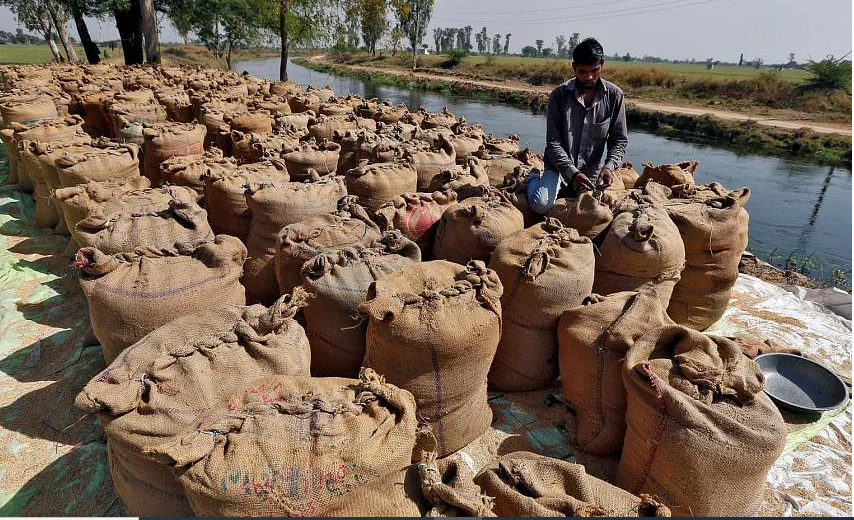PM Modi to release 19th instalment of PM-KISAN scheme at Bhagalpur, Bihar on Feb 24
Prime Minister Narendra Modi will release the 19th instalment of the PM-KISAN scheme at Bhagalpur, Bihar on Monday.
Food supply, already squeezed by shortages in wheat, corn and cooking oils, is at risk of even more disruption, this time from the rice market. India is clamping down on exports of the staple for half the world’s population, with the market’s focus now turning to the capacity of other major producers including Thailand and Vietnam to fill the gap.

(File Photo)
Food supply, already squeezed by shortages in wheat, corn and cooking oils, is at risk of even more disruption, this time from the rice market. India is clamping down on exports of the staple for half the world’s population, with the market’s focus now turning to the capacity of other major producers including Thailand and Vietnam to fill the gap.
The restrictions are threatening to ignite inflation for yet another key commodity, and may deprive some of the globe’s poorest nations of a crucial element of their diet.India is the single largest exporter with a 40 per cent share of global rice trade.
Advertisement
The government has imposed a 20 per cent duty on shipments of white and brown rice, and banned broken rice sales abroad. Those varieties mainly go towards feeding Asia and Africa and affect roughly 60 per cent of India’s overall rice exports.”Such severe disruptions in global supplies, combined with a record level of consumption worldwide, should supercharge” prices and further fuel food inflation, said Sabrin Chowdhury, head of commodities at Fitch Solutions.
Advertisement
When the war in Ukraine sent agricultural prices skyrocketing earlier this year, rice escaped the frenzy, keeping Asia and some Middle Eastern and African nations insulated from a bigger food crisis.The surge in corn and wheat encouraged some substitution away from these more expensive grains towards cheaper alternatives like rice. That may be about to change.
Higher costs
India’s policy will drive up its export prices to levels similar to white rice grades from rivals Thailand and Vietnam, prompting buyers to shift towards those suppliers instead, according to Chookiat Ophaswongse, honorary president of the Thai Rice Exporters Association.
When that happens, it will push up Thai and Vietnamese prices as well, dealing a blow to importing nations in Asia and Africa that consume the grain as a main staple, Chookiat said.”Imposing a 20 per cent levy is a big deal,” he said.
“This move will cause global rice prices to rally.”Thailand’s benchmark 5 per cent white rice was quoted at US$431 (S$603) a tonne this week by the exporters association, while the same grade from Vietnam was around US$393-US$397 a tonne India’s prices were well below that at around US$338-US$342.
While Thailand and Vietnam recently agreed to cooperate on boosting prices, without providing details, Chookiat said Thailand is unlikely to restrict exports as the country has a surplus and there are no worries about local supplies. Thailand usually produces about 20 million tonnes of milled rice a year, of which 11 million is consumed and the rest exported.
Chookiat said it’s impractical to curb overseas sales as the surplus, if left unsold, would hurt domestic prices and burden the government with storage costs and farmer subsidies.Back in 2007-2008, a global food crisis was triggered when both India and Vietnam restricted exports of rice. Prices soared above US$1,000 a tonne, more than double the level now, amid a panic over supplies.
Nguyen Nhu Cuong, head of Vietnam’s agriculture ministry’s crop production unit, declined to comment on whether the country would curb exports, but said domestic supply and national food security must be taken into consideration when mulling such a move.
Vietnam is able to ship 7 million tonnes of rice this year, up from an earlier forecast of about 6.7 million tonnes, he said. Globally, output in several regions has been hit by bad weather.
Besides India, which saw planting drop on lack of rain, China’s harvest is at risk from heat.Europe’s output is forecast to be the lowest since 1995-1996 on severe drought in Italy and Spain, while a similar trend is seen in the US, Chowdhury said. BLOOMBERG
Advertisement